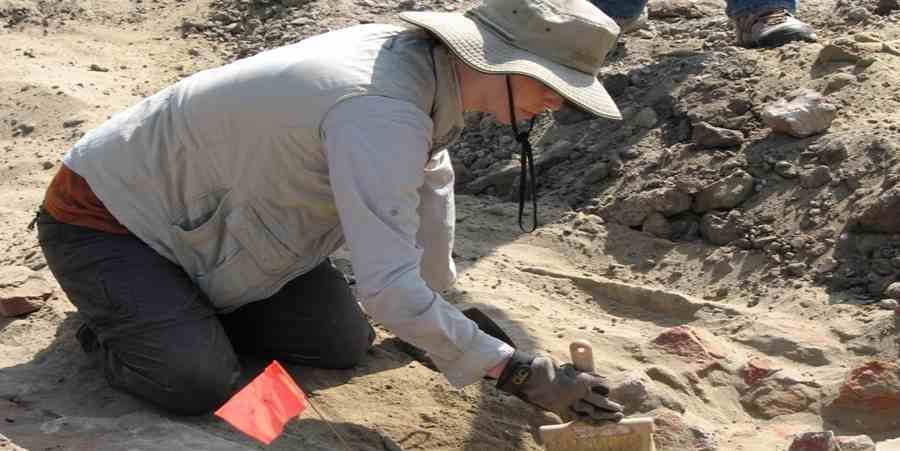The remains of giant fish from 150 million ago were discovered in woj. Lodz
They swam in the sea such as in the Caribbean; they reached more than 2 m in size and were covered with tough scales that resembled armor. They stunned their victims with their powerful mouths. The remains of such fish, from 150 million years ago, have been discovered by paleontologists in the Owadów-Brzezinki (Lodz) quarry.
The remains found are those of a ray-finned fish from dwoch groups, Halecomorphi and Pachycormiformes.
Pachycormiformes is an extinct branch of fish, whoora has no descendantsoin evolutionary. The largest specimens known from the fossil record reached a length of 12 m! – In ancient seas they took the place of today’s whalesow, by the way, were very similar to them. Someore fish from this group fed on plankton, but the fossils we discovered in Owadowo belonged to predatory fish,” Daniel Tyborowski, a PhD student at the Museum and Institute of Zoology of the Polish Academy of Sciences, tells PAP in an interviewory described both specimens.
Very similar in appearance – and leading a similar lifestyle – the second fish (from the Halecomorphi group, from the species Caturus giganteus). The only known wspoA modern living relative came from the Americas PoNorth . – Unlike their ancestorsow million years agooIn years, however, it is a species that reached very small sizes,” Tyborowski points out.
– Today, fish scales are generally very thin and flexible. The body of that fish was very smooth and shiny, and resistant to mechanical injury. It was a kind of spiny fish,” explains the scientist. This was due to ganoin – a very hard substance similar to enamel, whichora covered large and massive scales. Oprocz protective function of the scales was roThey also played a nutritional role, because – like bones – they were a storehouse of mineralsow, from whichorego organism mohead to draw on in a less favorable period.
The discovery was made in the Owad quarryow-Brzezinki in poThe northern part of the Gor Świętokrzyskie. This is one of the richest fossil sites in Poland – many of the specimens found thereow represents genera and species new to science. Among the most interesting fossils from 148 million years ago are m.In. The remains of the first flying reptile discovered in Poland – a pterosaur, a recently described species of marine reptile from the ichthyosaur group that is new to scienceow, the first Jurassic dragonfly wing known from Poland – and just a fish.
The area of today’s Poland then looked similar to today’s Caribbean – it was a warm, shallow sea dotted with thousands of islands and islets. Its bottom was the so-called. carbonate platform (it consisted of calcite, aragonite and roThe mineral remains were composed of calcium carbonate). – Fossils are well preserved in such an environment. When the fish we studied died and went to the bottom, they were surrounded by this specific, delicate sediment, ktory caused their tissue, despite the passage of millions ofoin years, is still preserved today – mowi doctoral student.
As Daniel Tyborowski pointed out, fish remains always attract the attention of paleontologistsow, as it is quite rare for scales to be preserved within theod fossils. Meanwhile, this is the second (after bivalves) most common group of fossils in this quarry. Similar rothe fish’s diversity is known from a site in Germany’s Solenhofen, one of the most famous and fossil-rich sites.
The scientist examined the two best-preserved specimens: jaws with part of the toothow. – At first it was not clear whether we were definitely dealing with fish remains or rather with large marine reptiles, ichthyosaurs, he recalls.
To resolve this, Tyborowski used a method that was innovative in Polish paleontology – microtomography, ktora allows "view" fossils without extracting them from limestone, in which theorych they are stuck (which could mean a high risk of damaging them).
The x-ray was performed in a laboratory at the University of Silesia. – The method has worked because there is a noticeable rothe difference in density between the specimen and the rock, which has been mapped by X-rays,” explains Tyborowski.
X-rays helped identify the organismoin and allowed us to obtain data based on whichorych was formed troA 3D printout of the jaws, magnified several times. – The print was initially intended to serve the mainownie as a prop during a lecture byoin popular science. However, it soon turned out that it allowed to see details ktore were not so clear when analyzing the image on the computer screen – mowi scientist.
The use of tomography and the study of tooth densityow made it possible to determine the particularoły nt. construction of the toothow. In one of the fish (Pachycormiformes) gorna part of the front teethow was covered with acrodentine – a variety of highly mineralized dentin. – This means that the front teeth were very resistant to mechanical trauma. At the same time, the mandible of the fish was very massive. Quite in front, on the other hand, it had a single, large and sharp tooth, the scientist pointed out.
What might the hunting of this fish have looked like a million years agooin years? Probably it struck its prey at high speed like a battering ram and scooped up its front tooth, similar to what the barracuda does today, Tyborowski believes.


